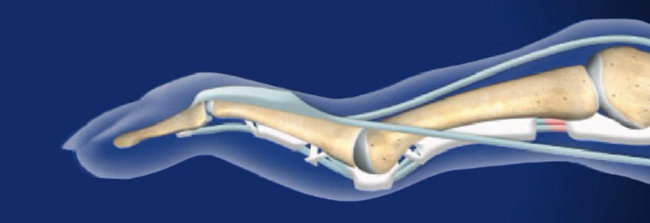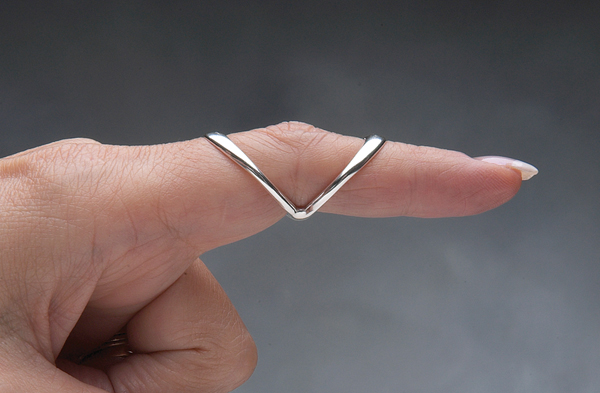Swan Neck Deformity: Splints, Causes, & Treatment
What is Swan Neck Deformity?
Basic knowledge of finger anatomy is useful to understand the complexity of Swan Neck Deformity. Each finger (except the thumb) is composed of three bones called phalanges. The joints between the phalanges are known as interphalangeal joints (IP joints). The joint at the fingertip is the distal IP joint (DIP joint) and the proximal IP joint (PIP joint) is the middle knuckle. Ligaments anchor bone to bone supporting the joints, while tendons connect the bones to muscle allowing movement. Extensor tendons on the back of the hand allow the IP joints to straighten and flexor tendons allow the fingers to bend into a closed fist.
When the fingers are straightened, the strongest ligament on the palm side of the PIP, known as the volar plate, tightens to prevent over extension of the joint. A lax volar plate results in hyperextension at the PIP, causing imbalance in the extensor tendons and allowing the flexor tendons to pull the DIP downward. Swan Neck deformity is characterized by hyperextension of the PIP accompanied by flexion of the DIP. This malformation is so named because this configuration resembles a swan’s neck.

What causes Swan Neck Deformity?
Any condition that results in laxity of the volar plate can cause Swan Neck Deformity. Rheumatoid Arthritis (RA) is the most common culprit. The overstretched volar plate occurs due to chronic inflammation of the PIP joint. Trauma, stroke, and various nerve disorders such as Parkinson’s and cerebral palsy can all affect the small muscles in the hand, weakening the volar plate, eventually leading to Swan Neck Deformity. Additionally, an untreated Mallet Finger can also result in Swan Neck Deformity.
What are the symptoms of Swan Neck Deformity?
If associated with trauma or RA there may be swelling, inflammation, or pain at the affected joints. Prior to the deformity becoming apparent there may be increasing difficulty flexing the fingers into a fist. Otherwise, the characteristic shape, in which the PIP is hyperextended while the DIP is flexed, is the most notable symptom. In severe cases, the affected finger cannot be flexed without assistance.

How is Swan Neck Deformity diagnosed?
A diagnosis of Swan Neck Deformity is usually evident upon physical examination. However, the physician will still require a complete medical history and review of symptoms to determine the underlying cause. X-rays may be ordered to visualize the joint surfaces and exclude fracture.
How is Swan Neck Deformity treated?
Non-surgical
Conservative management aims to treat the underlying cause of the deformity, restoring balance to the joints. Specialized splints may be used to prevent hyperextension of the PIP which should resolve the flexion of the DIP. Rigorous hand therapy, consisting of daily exercise, massages and stretching, is crucial to restore and maintain flexibility of the joints.

Surgical
When conservative measures fail, surgery is indicated. Several factors are considered in determining the type of procedure that is performed. In milder cases, the surgeon will realign, release and repair the soft tissues (skin, tendons, and ligaments) surrounding the PIP joint. Post-operatively this option requires extensive hand therapy to restore proper function.
The second option is a PIP joint arthroplasty. In this procedure the surgeon replaces the existing PIP joint with a new implant. Then the surrounding tissues are balanced to ensure proper mobility and flexibility of the new joint.
The final and most drastic option is joint fusion. Joint fusion binds the articulating surfaces and results in a joint that can no longer bend. Fusion can be done at the DIP, PIP or both. This procedure stabilizes the joint(s) and reduces pain and inflammation.
How can Dr. Knight help you with a Swan Neck deformity?
Whether because of trauma or Rheumatoid arthritis, Swan Neck deformity of the fingers can be a debilitating and painful condition. Over his many years of practice, Dr. Knight has acquired an extensive knowledge of these finger-specific ailments and he understands how important it is to reduce their effects, to allow you to return to your life, and your work.
See Dr. Knight, one of the best hand surgeons in Dallas and see if he can help you live a more pain free life. Come to our Southlake hand and wrist center or Dallas Fort-Worth friendly office location.
Swan Neck Deformity Fact Sheet
| What causes Swan Neck Deformity? | Several conditions can cause the symptoms that lead to a Swan Neck Deformity, such as trauma, a stroke, parkinson's disease and cerabral palsy. These conditions weaken the volar plate to which the flexor tendons are connected, as well as the small muscles of the hand, and set the stage for the deformity. |
| Can my Aswan Neck Deformity be treated without surgery? | While a doctor will need to diagnose the condition, if it is detected early enough then there are splints specially designed to hold the finger in a postion that will help the tendons heal correctly and reduce the deformity. |
| What medicines can I take to treat or stop a Swan Neck Deformity? | The underlying conditions listed above that can lead to a swans neck deformity can be treated with various medications, but the actual physical affects of the condition do nto respond to this type of treatment. |
| Will Swan Neck Deofrmity go away on its own? | If left untreated, the swan's neck deformity can indeed be permanent. While not as traumatically reductive of range of motion and use than some other conditions of the hands tendons, it will still make adjustent necessary, so it is best to seek medical treatment as soon as you suspect that you may be developing the condition. |
| How is Swan Neck Deformity treated by the doctor? | If the splinting and therapy first attempted to reverse the condition are not successful, then surgery may be necessary in order to stop the progression of the condition. The most common surgical remedy is a soft tissue repair, putting the internal mechanisms of the finger back in their appropriate places, but in the most sever cases, the joint may need to be entirely repalced with a synthetic implant. This is, as always, a last resort. |
| Can I get a Swan Neck Deformity in my thumb? | Yes, this condition can affect all fingers on the hand. |
Frequently asked Questions:
What causes a Swan Neck Deformity?
The most common cause of a swan neck deformity is rheumatoid arthritis. It can also be caused by any condition that weakens the small muscles of the hand and fingers, such as a stroke, trauma, or even cerebral palsy. It is also possible to develop a Swan Neck deformity as the result of an untreated mallet finger, as the same muscles and tendons are involved in both conditions.
How can I treat a Swan Neck Deformity at home?
Conservative treatment of a swan neck deformity is unique, and involves the use of a very specific type of splint that was designed to precisely remedy the tendon damage that creates the deformity. The splint looks like two rings joined in a V shape at the bottom, which cradle the central knuckle of the affected finger. This makes it so that the proximal interphalangeal joint cannot hyperextend, which then allows the tendon to rest and heal, reversing the damage caused by the condition in the first place.
Do I need surgery for a Swan Neck Deformity?
In most cases, conservative treatment of the condition is effective and surgery is not required, but in the most extreme examples, one of two types of surgery may be required. The lesser option involves the repair and realignment of the tendons and soft tissues of the proximal interphalangeal joint which will reverse the symptoms and allow the finger to heal properly and give you back your comfort and range of motion.
Animated Videos
(817) 382-6789
Disclaimer
HandAndWristInstitute.com does not offer medical advice. The information presented here is offered for informational purposes only. Read Disclaimer

























